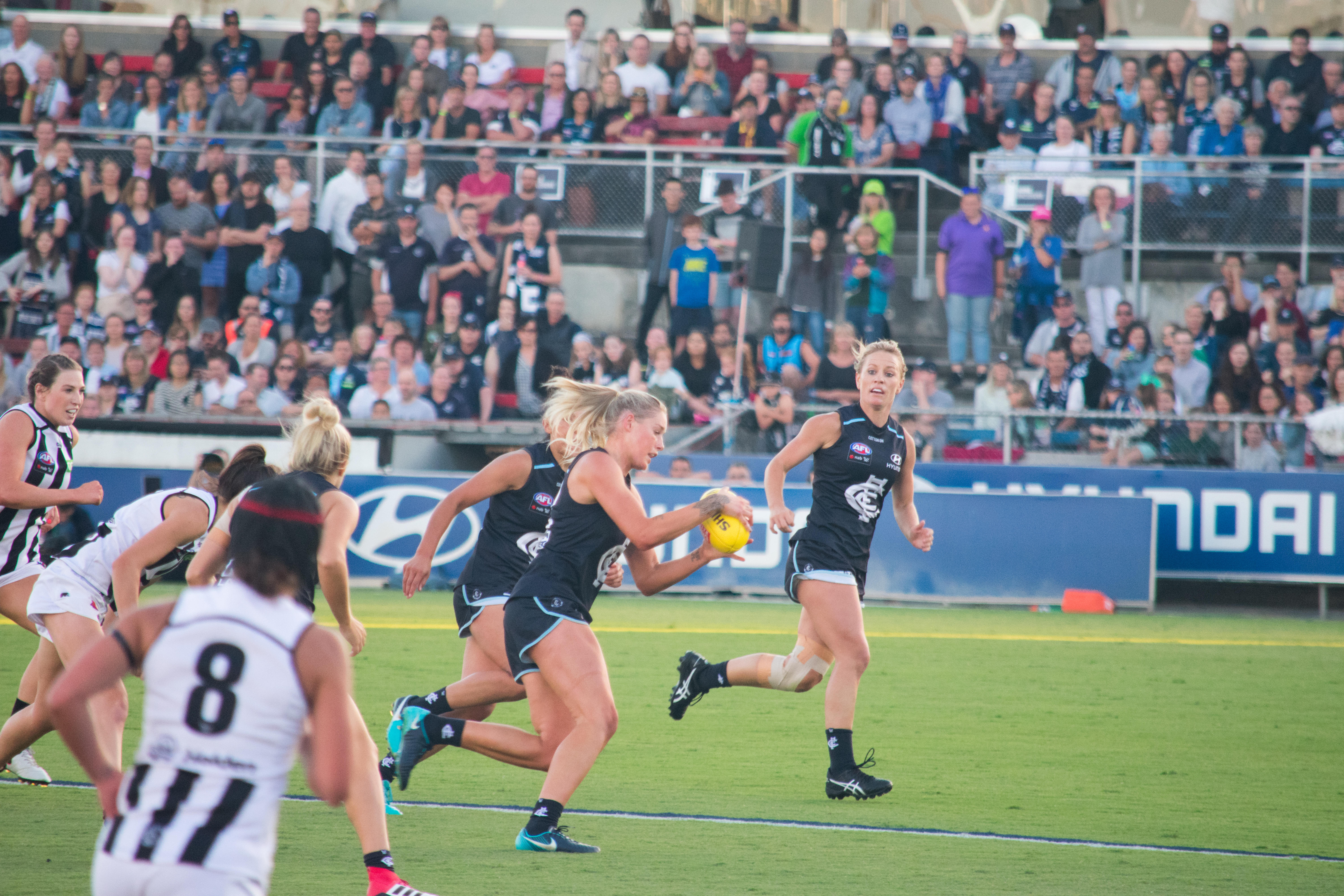Australian Rules football is a highly popular winter game in the southern states of Australia. Its official name is Australian football. Invented by Australians, it is played mainly in Australia, Papua New Guinea, and Nauru. It is also played in more than 30 other countries by small groups of teams that consist mainly of Australians. Every year, official teams representing Australia and Ireland play each other using international rules that mix elements of Australian and Gaelic football.
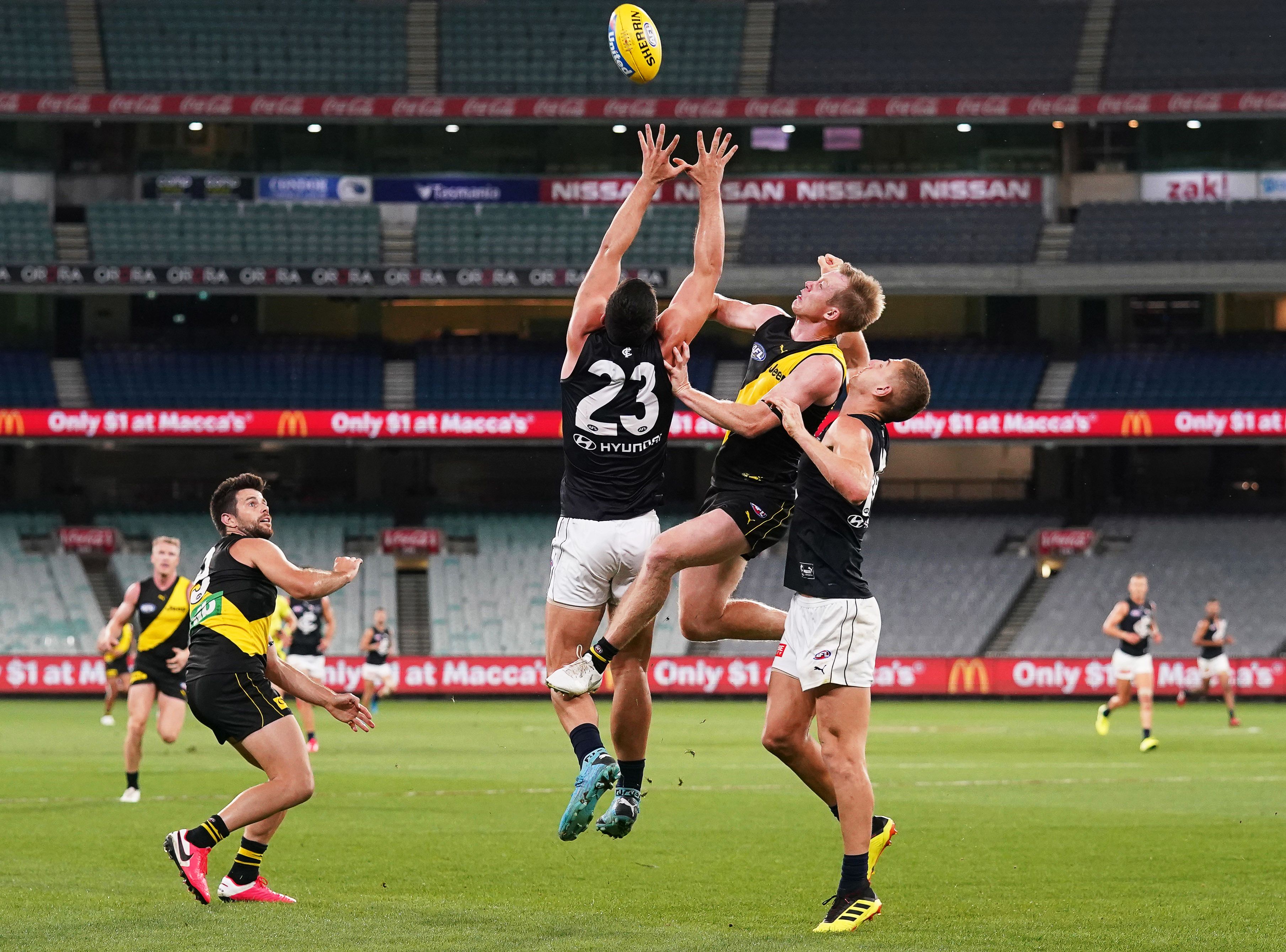
On Saturday afternoons in winter, hundreds of thousands of spectators flock to the major club competitions in South Australia, Canberra, Northern Territory, Tasmania, Victoria, and Western Australia. Teams from Sydney, Adelaide, Perth, and Brisbane also compete with leading Melbourne teams. Australian Rules football is a game of great pace and spectacle. Players drive the ball back and forth with long kicks and quick hand passes and stop it with high catches called marks.
An Australian Rules football team consists of 18 players and up to 4 interchange players, who can replace other players. During a match, each team tries to score as many points as possible and to prevent the opposition from scoring. The team that scores the highest number of points wins the match.
A game of football
A game of Australian Rules football lasts 80 minutes of actual playing time, divided into equal quarters. This time does not include the intervals between quarters nor extra time, which occurs when a ball is out of bounds or after a goal is scored. Teams change scoring ends at the end of each interval.
An Australian Rules football field is an oval that measures 361 to 509 feet (110 to 155 meters) wide and 443 to 607 feet (135 to 185 meters) long. At each end of the field stand two tall posts, called goal posts, which are flanked by two shorter posts, called behind posts. The four posts are in a straight line, and are 21 feet (6.4 meters) apart.
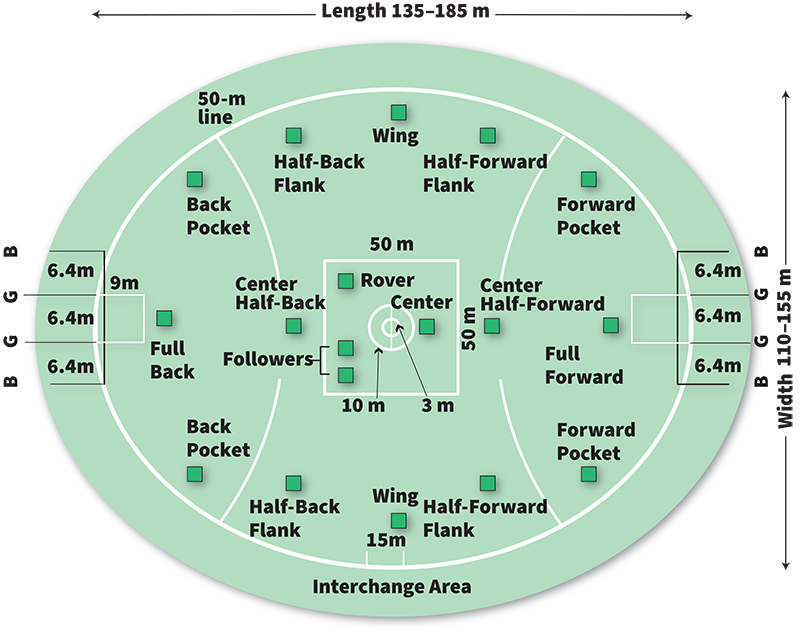
The start of a game.
The opposing captains toss a coin to decide the direction in which each team will kick in the first quarter. The two teams then take their places on the field.
On each team, 15 players take up set positions, with the forwards (attackers) at the end toward which the team is kicking. The backs (defenders) at the other end of the field mark (guard) the other team’s forwards. The center line players take up positions across the center of the ground. Another three players make up the following division, or ruck. A division consists of a ruckman, a ruck rover, and a rover. These players, called followers, should follow the ball wherever it goes. Each team has three players designated as the second ruck—two other ruckmen and a second rover. If a member of the first ruck needs a rest from following the ball, he changes with his counterpart, and “rests” in one of the 15 fixed positions. When the second ruckman or second rover gets tired, they return to their fixed position.
At the start of a game, members of the first rucks of the opposing teams take up positions around the center circle. The umpire begins the game by bouncing the ball in the circle. He holds the ball evenly and tries to get a straight, high bounce. When the ball is in the air, the opposing ruckmen vie with each other in trying to hit the ball with their fist or palm to the rover, or possibly to the centerman. But there is no fixed method of positioning at the center bounce. Only four players from each side are allowed inside the 164-foot (50-meter) square when the ball is bounced.
From the bounce, players knock, punch, or kick the ball forward, backward, or sideways. Their main objective is to get the ball and then to either kick for a goal or pass the ball to a teammate in a more advantageous position with a foot pass or a hand pass.
The play.
The forwards try to move into positions that allow the player with the ball to pass to them without giving the defenders a chance to intercept it. The defenders try to keep as close as possible to the forwards they are marking to stop the pass and the attacking movements.
The player with the ball must quickly notice which of his teammates is in a good position, and pass the ball to him. This player tries to kick for a goal or passes the ball to another teammate in a better position. Often a player has to pass the ball to a teammate who is leading—that is, breaking away from his opponent and, at the same time, calling for the ball.
If the player receiving the ball marks (catches) it, or if he is fouled by an opponent, he is entitled to a free kick. His opponent tries to beat him to the mark, or tries to spoil the mark by knocking or punching the ball away. Even if his opponent only touches the ball, no mark is possible, and the umpire calls for play to continue. If the umpire awards a player a free kick, the player either plays on or chooses to stop and have a set kick. The place where the player marks the ball is also known as the mark. An opponent stands on this mark to make the kick as difficult as he can.
If the player with the ball wishes to handball (hand pass) it to a teammate, he must hold the ball in one hand and hit it with the clenched fist of the other hand. The player receiving the hand pass must play on. He tries to break away from his opponent and drive the ball forward. Sometimes a pass receiver finds himself unopposed and runs with the ball instead of kicking it immediately. But he must bounce or touch the ball on the ground every 49 feet (15 meters).
Scoring.
A player can score a goal only if he kicks the ball between the goal posts and the ball is not touched before it passes through the posts. A player can kick a goal from any direction or distance, and the ball can bounce through the goal posts or go through higher than the posts. If the ball passes between a goal post and a behind post, it counts as a behind, even if the ball has been touched beforehand. A ball that hits a goal post also counts as a behind. If the ball hits a behind post, it is out of bounds. A goal counts as six points and a behind as one point. 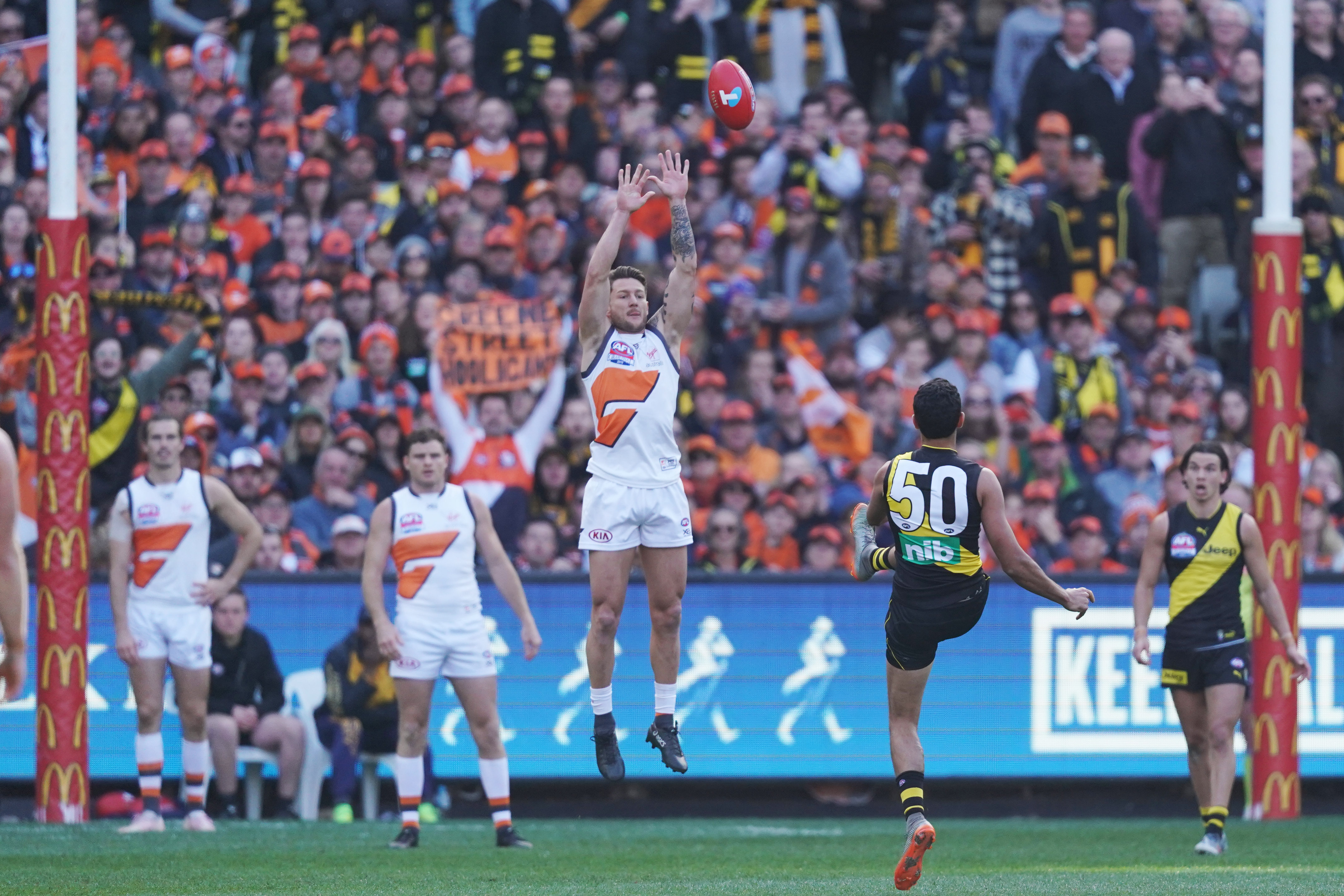
Restarting play.
When a team scores a goal, the central umpire restarts the game by bouncing the ball in the center circle. When a team scores a behind, a defender of the other team, usually the full back, kicks off from inside a rectangle drawn from the goal posts. The rectangle is 30 feet (9 meters) long and 21 feet (6.4 meters) wide. The full back can kick off in any direction he chooses, but he usually kicks the ball to one flank. This makes it difficult for the players of the opposing team to shoot at the goal. If the full back goes outside the rectangle before kicking the ball, the umpire brings the ball back and bounces it on that line.
When a ball goes out of bounds, the boundary umpire signals to the central umpire. The central umpire halts play and brings the ball back to the out-of-bounds spot. The boundary umpire then restarts the game with a throw-in, throwing the ball high over his head between 33 and 49 feet (10 and 15 meters) into the field. Opposing ruckmen usually contest the throw-in. They try to hit the ball to the rover or to another teammate.
Controlling play.
In the Australian Football League, seven umpires control an Australian Rules football match—three central umpires who are responsible for upholding the laws of the game, two boundary umpires, and two goal umpires. The central umpires are the main referees. The other umpires must wait for a central umpire’s all-clear signal before they act on their decisions.
Two timekeepers, one from each club, are responsible for keeping the playing time. They record the actual playing time on special timepieces, and rely on hand signals from the central umpires when play has been held up. Lost time varies, but is usually between four and six minutes a quarter.
Playing football
A good football player should be capable of playing in a number of positions. Often, a coach makes his players change positions to gain a winning break or to prevent an opposing player from dominating the game. A player must be able to kick the ball well with either foot, know when and how to use any of five kinds of kicks, and be able to place the ball accurately with a foot pass and a hand pass. He must be able to mark from any position, bump and tackle an opponent, avoid a tackle by twisting and weaving, and bounce the ball correctly.
The followers
are virtually a team within a team. Many experts consider the ruck to be the “powerhouse” of a team. The work of a ruckman often takes years to perfect. Ruckmen and rovers must develop a close understanding of each other.
A ruckman is usually a tall, strong man who is capable of leaping high, and who possesses good judgment in taking high marks or in contesting a bounce or a throw-in. A good ruckman must be able to vary the style of his play.
A rover is usually a small, fast, and clever player. He is often one of the best players on the team. A good rover must be able to pick up a ball quickly in a pack of players, weave around opponents after receiving the knock from his ruckman, and break away to put his team into attack.
Center line players
consist of two wingmen and a centerman. These players perform dual roles, alternating between being defenders and forwards. They have to know when to defend and when to attack. When the opposing side has the ball, they try to keep their center line opponents from receiving the ball. When their own side has the ball, they try to get away from their opponents to be free to receive a foot pass or a hand pass.
Center line players are usually good kickers who can pass the ball accurately to forwards. Wingmen are usually relatively small, fast men—they may have to make long dashes for the ball. Good center line players know how each forward likes the ball to be passed to him. They must know the manner of play of each defender, because they must receive his kicks.
Forwards
try to beat their opponents either by skill or by speed, and score goals or help in scoring them. Many people believe that a forward has a more difficult task than a defender has. A forward generally has to make a full turn when he receives the ball before he can kick it toward the goal. But a defender often has only to keep going straight ahead to clear the ball.
A good forward knows the kicking capabilities of all players who are going to kick to him. He watches the ball intently when it is being kicked to him. Even from about 200 feet (about 60 meters) away, he can see if a pass is going to be accurate or slightly off line. The forward gets in front of his opponent to receive and control the ball.
Forwards should keep strictly to their own positions and not crowd other forward positions. If play becomes crowded in the forward lines, it becomes difficult to create opportunities for clear, unhurried shots at the goal. By keeping to their positions, forwards create plenty of space in which to move and to use their skills.
A half forward flanker must be a specialist in his position, because his spot on the field is often bypassed. He must be patient and not crowd the center half forward or the full forward.
A center half forward is usually a mobile, high-marking player. He can either make short passes to his full forward or kick goals from a long distance.
A full forward is usually the team’s “goal getter.” He must be good at kicking and marking. A good full forward is agile enough to scoop the ball from the ground quickly and to leap high for marks. He can kick goals from a long distance with set kicks or with quick shots from sharp angles.
Forward pockets should keep out of the way of the full forward to give him plenty of room to lead for a possible pass. A ruckman resting in a forward pocket can move into the goal square as the full forward leads out, giving the kicker a choice between a short pass to the full forward or a long kick to the goal square. If the ball comes high, a rover resting in a forward pocket should move toward it and should gather it if other players cannot.
Defenders
try to prevent their opponents from receiving a foot pass or a hand pass. Defenders must beat their opponents to the ball, punch the ball away when their opponents leap for a mark, tackle quickly, and guard closely. They must be determined to get the ball and must be willing to attempt tackles that appear impossible. Defenders should place themselves on the inside of their opponents, forcing the opposing forwards to play near the boundary line. These tactics make accurate shooting at the goal more difficult.
Defenders must be prepared to sacrifice their own game for the sake of their team. For example, a defender might take a brilliant mark over a forward. But, if the forward outmarks him, the resulting kick from the mark may score an easy goal for the opposing team. Most defenders try to prevent this possibility by spoiling the mark.
The full back and the two back pocket players should avoid taking risks, because errors of judgment in this area allow opponents to score. But the center half back and the two back flankers can attack as well as defend. In fact, a half back who leaves his forward and dashes out to gather the ball can send his team into attack with a good kick.
Talking among players helps create teamwork on the field, especially in the back lines. A word from a teammate at the right time gives a player confidence that he is doing the right thing or warns him that an opponent may tackle him from behind.
Handling the ball.
Handballing is a major method of passing the ball. To handball, hold the ball firmly in one hand and punch it with your other hand. You are not permitted to throw the ball to another player, nor are you allowed to throw the ball up and then hit it. You may use a handball to get out of difficulties or create an attacking movement. If you are unable to kick the ball, you may be able to handball it quickly to a teammate. You may also handball it to a teammate who is in a better attacking position, even when you could kick it yourself. Since the 1950’s, handballing has been used increasingly to the point where in the modern game more hand passes than kicks are often used in a match. 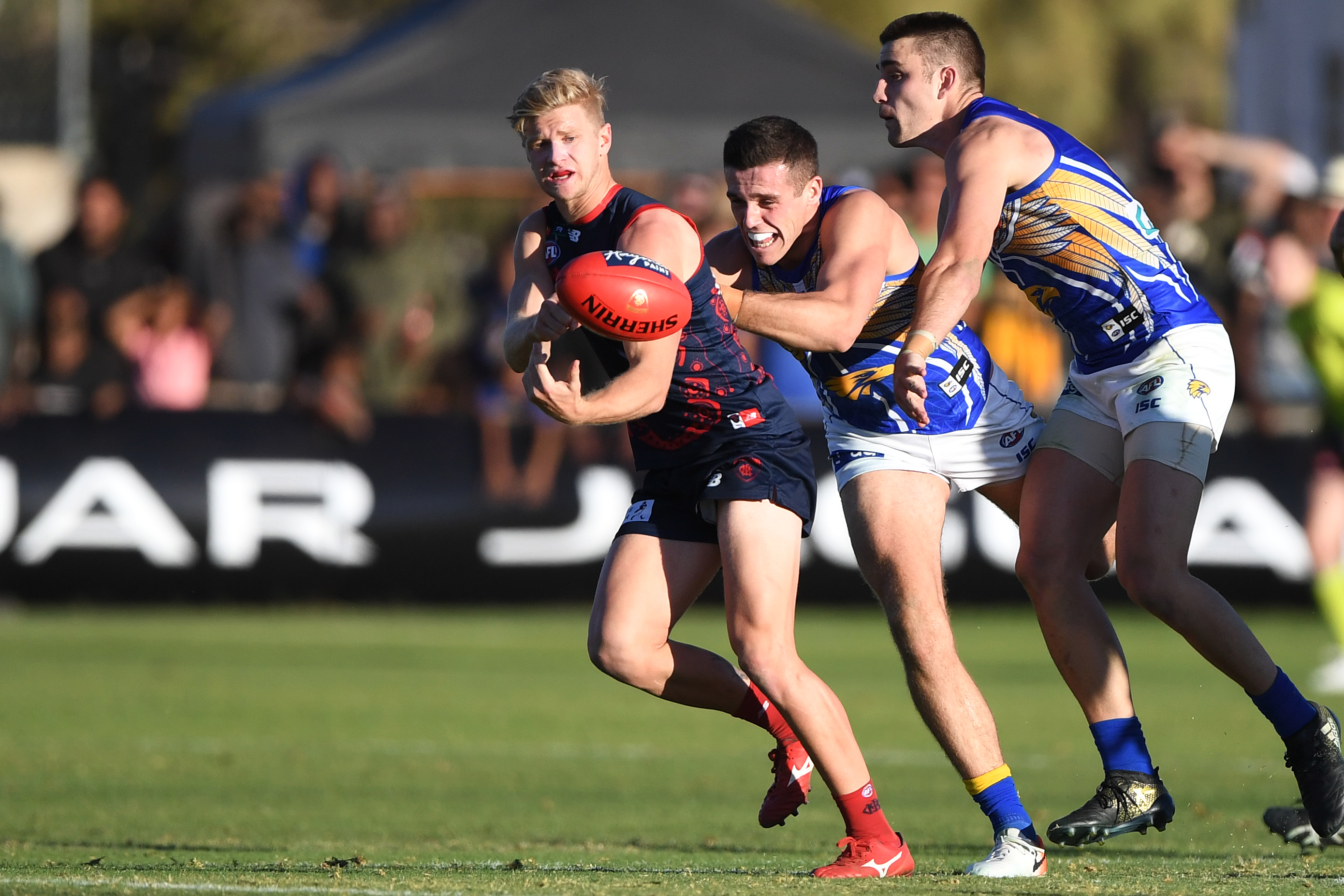
Marking the ball is one of the most impressive features of Australian Rules football. One of the fundamentals of marking is to keep your eyes on the ball. Judge the flight of the ball and leap only when you consider it necessary.
For an overhead mark, you should extend your arms and stretch your fingers out and slightly forward to meet the ball. Try to grasp the ball rather than let it strike your hands.
For a chest mark, allow the ball to hit your chest instead of trying to catch it with your hands. As the ball hits your chest, wrap your arms tightly around it and hug it to your body. If you are marking a ball with the wind behind it, come from behind your opponent, because the ball is likely to travel farther. If the wind is blowing against the ball, try to get in front of your opponent, because the ball is likely to drop short suddenly.
Bouncing the ball correctly takes practice. Throw the ball down straight, at an angle of about 45 degrees to the ground. You will find it hard to do at top pace, even when the ground is firm and dry. On wet ground, most players touch the ball on the ground, even though it is slower.
Kicking.
A good team has players who can pass to one another accurately and who can kick for a goal with certainty. Good players know when to use a particular kind of kick.
To drop kick correctly, drop the ball at an angle of about 45 degrees to the ground, with the long seam of the ball in line with your target. Kick the ball just after it hits the ground, keeping your toes pointed downward. Swing your kicking foot right through to gain distance with the kick. Keep your head down and your eyes on the ball. The drop kick was once popular, but it is seldom used today because it involves a high possibility of error.
The stab kick is similar to the drop kick but is used for fast passing over short distances. To stab kick, drop the ball at an angle of about 60 degrees to the ground and closer to your body than you would for a drop kick. Kick the ball with a stabbing action just as it hits the ground. Do not follow through. Like the drop kick, the stab kick is seldom used because it involves a high possibility of error.
The punt kick is the simplest kick. It requires less balance and care than any other kick. Players use it when they have little time to kick carefully. But punt kicks are difficult for other players to mark, because the ball moves unevenly through the air. To punt, kick the ball when it is about 15 inches (about 40 centimeters) above the ground, with a good follow-through.
The drop punt is the most commonly used kick in the modern game. It gets its name from the action of the player, who drops the ball from the hands almost to the ground level before kicking it. The ball spins end over end, making it easy to catch. Try to kick the ball on the spot where the four seams meet.
The torpedo punt gets its name from a kick that causes the ball to spin like a torpedo. It is used when a player wants increased distance or is kicking into the wind. To make a torpedo punt, hold the ball at an angle to your body and kick it slightly on the side of your boot.
Tackling.
A player can tackle only the player who has possession of the ball. He can grasp the ball carrier only between the shoulders and the knees. If a defender tackles above the shoulder, the umpire awards a free kick for “over the shoulder” or “around the neck”. If he tackles below the knees, the umpire awards a free kick against him for “tripping.” The umpire also awards a free kick to any player who is tackled without the ball. But a player with the ball may be bumped by an opponent who uses his hip, shoulder, chest, arm, or hand. When the player with the ball is tackled, he must kick the ball, or handball it. He cannot hold or drop the ball. 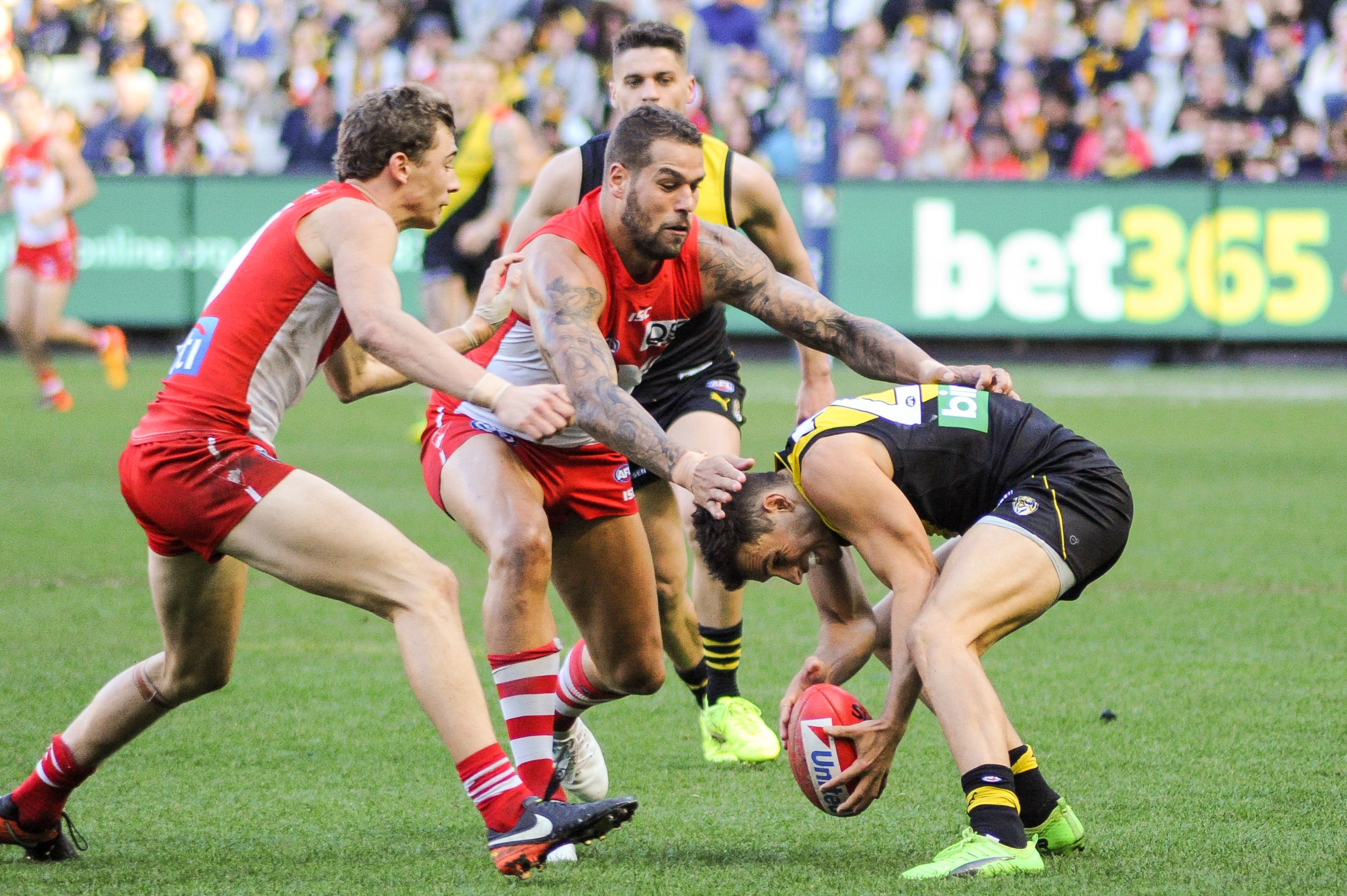
A player may also shepherd a teammate who has the ball by keeping opposing players away from him. He may push or shoulder an opponent in the chest or side, provided that the opponent is within 16 feet (5 meters) of the ball. A player usually shepherds a teammate by extending his arms between him and the opponent. But he must not hold the opponent back, nor keep him from leaping for a mark or a throw-in.
Penalties.
The central umpire usually awards free kicks against players for illegal tackling, holding a player who does not have possession of the ball, handballing incorrectly, taking too much time, and holding or dropping the ball when held. Umpires award a penalty against a player who tackles, holds, or makes contact high on the body against an opponent who has passed the ball. The umpire also awards a free kick against a player who interferes with a player who is going for a mark or a throw-in.
Sometimes, the umpire must bounce the ball, as when play is restarted. For example, if a player tackles the ball carrier and holds the ball onto him, the umpire must bounce the ball. This also occurs when two players mark the ball at the same time or when a pack of players keep the ball from being played freely.
Organization of football
Australian Rules football is played mainly in South Australia, Tasmania, Victoria, and Western Australia. But the game is also gaining popularity in the other states and in the Australian Capital Territory. Hundreds of thousands of people play in competitions throughout Australia, not including school competitions.
Junior football teams, entirely amateur and organized by adults, are among the major reasons for the popularity of the game. Local teams in suburbs, small towns, and cities play in competitions for boys under the ages of 12, 14, 16, and 18, and in open-age competitions. Usually, 8 to 12 clubs in an area band together to play each other. Many skilled young players progress through each grade until they become full members of a senior team. Local competitions are strictly amateur. Many clubs employ part-time playing or nonplaying coaches.
Each state has a major competition in its capital city. Players are paid for playing in this major league. Some players are professional, but most have careers separate from football. For these players, football is only a part-time occupation.
Associations.
The Australian Football League (AFL) is the controlling body of Australian football throughout Australia. It has headquarters in Melbourne. The AFL is responsible for advancing the game throughout the country and for making changes and additions to the existing laws. Each state also has its own controlling body. These organizations are the AFL New South Wales/Australian Capital Territory, the AFL Queensland, the Northern Territory Football League, the South Australian National Football League, the Tasmanian Football League, the Victorian Football League, and the West Australian Football League.
Every football club is affiliated with the controlling body in its state. In Victoria, South Australia, Western Australia, and Tasmania, officials from the major league clubs personally represent their clubs at the meetings of the controlling bodies.
The major league clubs are:
Australian Football League (AFL).
Adelaide, Brisbane, Carlton, Collingwood, Essendon, Fremantle, Geelong, Gold Coast, Greater Western Sydney, Hawthorn, Melbourne, North Melbourne, Port Adelaide, Richmond, St. Kilda, Sydney, West Coast, and Western.
South Australia.
Adelaide, Central District, Glenelg, North Adelaide, Norwood, Port Adelaide, South Adelaide, Sturt, West Adelaide, and Woodville-West Torrens.
Western Australia.
Claremont, East Fremantle, East Perth, Peel, Perth, South Fremantle, Subiaco, Swan Districts, West Coast, and West Perth.
Tasmania.
Clarence, Glenorchy, Kingborough, Lauderdale, Launceston, North Hobart, and North Launceston.
AFL Season.
Teams in the AFL play a regular-season schedule of 22 games. The eight teams with the best win-loss records advance to the playoffs. The eight teams play a series of playoff games until two teams are left. The final two teams play in the Grand Final, the AFL’s championship game. 
Awards for players.
In the major competitions of each state, central umpires choose the three best and fairest players in each match, and submit their names to the controlling bodies. The umpires select the best players on skill and personal behavior. They award the best players 3 points, the second best 2 points, and the third best 1 point. At the end of the season, the players with the most points win “best and fairest” awards. The Charles Brownlow Trophy, better known as the Brownlow Medal, is the most prestigious award in the AFL, and is given to the best and fairest player during the regular AFL season. The Norm Smith Medal is awarded to the outstanding player in the AFL Grand Final.
History
Australian Rules football started in the early 1850’s, when immigrants developed a game based on Gaelic football. Early games were rough-and-tumble affairs with few rules. During the late 1850’s, boys from Scotch College in Melbourne began playing with footballs that their sports master imported from the United Kingdom. In 1858, they challenged boys of Melbourne Grammar School to a football match. Each team consisted of 40 players. The two sets of goal posts were 1 mile (1.6 kilometers) apart, and the first team to score two goals won the match. After almost 5 hours of play, the only score was one goal by Scotch College. The match was abandoned. Many experts believe that this match was the first game of Australian Rules football.
In 1859, H. C. A. Harrison and Tom Wills drew up the first set of rules for the Melbourne Football Club. But the rules did not provide for umpires. Captains had to claim free kicks from the opposing captains. Club officials appointed the first umpire in 1872.
In both Victoria and South Australia, interclub competitions became popular and well organized. In 1877, matches between colonies began when two Melbourne clubs visited Adelaide to play against the local teams. That same year, Melbourne clubs formed the Victorian Football Association. Soon there were too many clubs for the one competition in Victoria. The association formed two competitions—one for clubs in inner Melbourne, the other for clubs in outer Melbourne. In 1896, the inner clubs formed their own association. They called it the Victorian Football League. During this time, clubs in other parts of Australia formed football associations. In 1877, four Adelaide clubs formed the South Australian Football Association. In 1885, four Perth clubs started the Western Australia Football Association. In Tasmania, three clubs formed the Tasmanian Football Association in 1906. The Australian National Football Council was also established in 1906. In 1908, the council held the first Australian Football Championships, which Victoria won.
In 1982, the Victorian Football League attempted to make Australian football a national game by relocating the South Melbourne teams to Sydney, where Rugby League was the dominant game. The new team, known as the Sydney Swans, was followed by a team from Brisbane, another stronghold of Rugby League. A team from Western Australia, where Australian football is the main game, was also added to the Victorian Football League. To reflect its new national scope, the Victorian Football League changed its name to the Australian Football League following the 1989 season. In the 1990’s, three more non-Victorian teams were added—Adelaide, Fremantle, and Port Adelaide. The AFL added a team from Queensland’s Gold Coast in 2011 and one from Greater Western Sydney in 2012.
In 2017, the Australian Football League Women’s (AFLW) began with 8 teams. Currently, the league has 18 teams. The rules for the AFLW are essentially the same as for the AFL. AFLW games use a slightly smaller ball than the one used in AFL games. AFLW teams consist of 16 players, as opposed to 18 for the AFL. AFLW quarters run for 15 minutes, as opposed to 20 minutes for the AFL. 